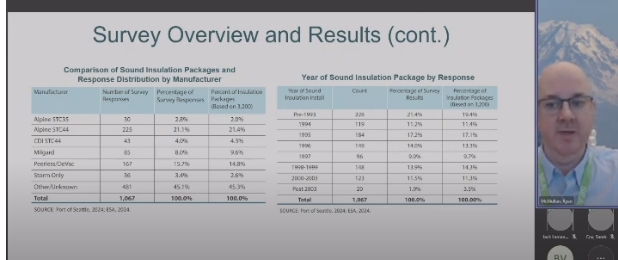At the March 26 Highline Forum, the Port of Seattle presented an update on its Sound Insulation Repair and Replacement Pilot Program (SIRRPP). Their Aviation Noise Program Manager delivered a technically polished slide deck and report. But for the thousands of homeowners still dealing with defective Port Packages, this presentation was a stark reminder that the Port still is not telling the full truth. Minimizing the problems. Avoiding talking about their ability to fix them.
What the Port Said, What They Left Out
Below, we break down the key claims made by the Port and provide the Reality Check—grounded in public records, statute, and lived experience.
“We’ve allocated $6.5 million for Port Package repairs.”
Reality Check: The Port is sitting on a mountain of money but has chosen to spend a fraction—outside the State Port Package Update Account created last year (SB5955). That fund was established to allow contributions from any source—federal, state, local, and the Port of Seattle.
The Port did allocate money in 2024.
However, they spent the past year using that money to do this study. They haven’t fixed anything to date.
And they have not allocated one more dollar since. San Francisco International Airport (SFO) has been setting aside money every year, automatically – and fixing problematic sound insulation systems. In contrast, the Port asks cities and StART members to help them lobby for the State and Federal government to provide further funding!
Let’s be clear: under Washington State law (RCW 53), the Port has full authority to fund upgrades to existing Port Packages, including ventilation and indoor air quality. They do not need federal permission. They can contribute money every year into the state fund. They just don’t choose to.
2. “We followed a careful 3-phase process with survey and testing.”
Reality Check: The Port’s “process” has been structured to delay repairs and limit responsibility. Their 3-phase approach—planning, surveying, reporting—sounds thorough, but only 30 homes were inspected out of more than 9,400 that received Port Packages. That’s 0.3%.
3. “We surveyed 3,200 homes and had a 33% response rate.”
Reality Check: That survey excluded more than two-thirds of Port Package recipients. The Port deliberately limited the survey area to the 2014 FAA noise boundary (DNL65), which shrank the eligible geographic area by two-thirds and eliminated 85% of affected residents with current Port Packages. Many of those homes are still experiencing window failures, mold, and unsafe indoor air. The survey results are neither representative nor statistically valid. We reject them as a policy basis.
4. “The packages are still acoustically effective.”
Reality Check: The Port keeps repeating this line because it distracts from what residents are actually experiencing: mold, water intrusion, rotting window trim, broken seals, and rising utility bills. Acoustics are only part of the story.
The installations were defective—and the Port never ensured quality. Concerns about its failure to follow FAA C6 Grant Assurance obligations (quality inspections) were raised as early as 1998. The largest vendor declared bankruptcy in 2002 – even before the insufficient 10 year warranties had expired. No oversight. No accountability. Just thousands of failed systems.
5. “We’re focusing on homes insulated before 1993, per FAA guidance.”
Reality Check: The Port’s own data shows that packages failed within 5–10 years—regardless of installation date. Using 1993 as a line in the sand is not about need or fairness. It’s about minimizing cost. The Port can legally assist any homeowner with a failed Port Package today—if it chooses to.
6. “We’re committed to gathering more data.”
Reality Check: Homeowners aren’t lacking in data—we’re drowning in it. What we’re lacking is action. Even with the Port admitting that 99% of installations are past their useful life, it has no plan to systematically upgrade them.
What Should Happen Now?
- The Port should contribute $5 million per year into the State Port Package Update Fund—immediately.
- It should stop using the 2014 DNL65 boundary and 1993 cutoff to limit eligibility. These do not apply to existing systems. They are simply arbitrary and exclusionary.
- It must acknowledge the installation failures and commit to fixing all defective Port Packages—starting with the homes already surveyed and documented.
- Cities and community advocates must do more to remind the Port what it can already do! At every Highline Forum and StART meeting, members should insist that the Port automatically fund the Port Package Update account every year. Every time we work with the Port’s lobbying team we should be carrying our message to them, not just carrying their message to Olympia and D.C.
- And community activists like you need to remind Highline Forum and StART members to do this.
The Bottom Line
The Port doesn’t need permission or outside money. It simply needs everyone, especially the local electeds at the Highline Forum table, to remind it to spend its own money and get your Port Package fixed!
It has the legal authority to do the work. It has money to do more on its own. And it has 9,400 reasons to act. Every day it delays is another day families live with cracked windows, mold, and broken promises.
We don’t need another study. Or outside funding. We need the Port to fix your Port Package. Now.
